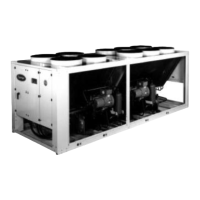4
Prior to the initial start-up of the 30HXC/GX units, the
people involved in the on-site installation, start-up, operation
and maintenance of this unit should be thoroughly familiar
with these instructions and the specific project data for the
installation site.
The 30HXC/GX liquid chillers are designed to provide a
very high level of safety during installation, start-up, opera-
tion and maintenance. They will provide safe and reliable
service when operated within their application range.
This manual provides the necessary information to fami-
liarize yourself with the control system before performing
start-up procedures. The procedures in this manual are
arranged in the sequence required for machine installation,
start-up, operation and maintenance.
Be sure you understand and follow the procedures and
safety precautions contained in the instructions supplied
with the machine, as well as those listed in this guide.
To find out, if these products comply with European
directives (machine safety, low voltage, electromagnetic
compatibility, equipment under pressure etc.) check the
declarations of conformity for these products.
After the unit has been received, when it is ready to be
installed or reinstalled, and before it is started up, it must be
inspected for damage. Check that the refrigerant circuit(s)
is (are) intact, especially that no components or pipes have
shifted (e.g. following a shock). If in doubt, carry out a leak
tightness check and verify with the manufacturer that the
circuit integrity has not been impaired. If damage is detected
upon receipt, immediately file a claim with the shipping
company.
Do not remove the skid or the packaging until the unit is
in its final position. These units can be moved with a fork
lift truck, as long as the forks are positioned in the right
place and direction on the unit.
The units can also be lifted with slings, using only the
designated lifting points marked on the unit.
These units are not designed to be lifted from above. Use
slings with the correct capacity, and always follow the
lifting instructions on the certified drawings supplied with
the unit.
Safety is only guaranteed, if these instructions are carefully
followed. If this is not the case, there is a risk of material
deterioration and injuries to personnel.
Never cover any safety devices.
This applies to the relief valve in the water circuit and the
relief valve(s) in the refrigerant circuit(s).
Ensure that the valves are correctly installed, before
operating the unit.
In certain cases the relief valves are installed on isolating
valves. These valves are factory-supplied lead-sealed in the
open position. This system permits isolation and removal
of the relief valves for checking and replacing. The relief
valves are designed and installed to ensure protection
against overpressure caused by fire.
All factory-installed relief valves are lead-sealed to prevent
any calibration change. If the relief valves are installed on
a change-over manifold, this is equipped with a relief valve
on each of the two outlets. Only one of the two relief valves
is in operation, the other one is isolated. Never leave the
change-over valve in the intermediate position, i.e. with both
ways open (locate the control element in the stop position).
If a relief valve is removed for checking or replacement
please ensure that there is always an active relief valve on
each of the change-over valves installed in the unit.
The safety valves must be connected to discharge pipes.
These pipes must be installed in a way that ensures that
people and property are not exposed to refrigerant leaks.
These fluids may be diffused in the air, but far away from
any building air intake, or they must be discharged in a
quantity that is appropriate for a suitably absorbing
environment.
Periodic check of the relief valves: See paragraph ‘Mainte-
nance safety considerations’.
Provide a drain in the discharge circuit, close to each
relief valve, to avoid an accumulation of condensate or
rain water.
Ensure good ventilation, as accumulation of refrigerant in
an enclosed space can displace oxygen and cause asphyxia-
tion or explosions.
Inhalation of high concentrations of vapour is harmful and
may cause heart irregularities, unconsciousness, or death.
Vapour is heavier than air and reduces the amount of oxy-
gen available for breathing. These products cause eye and
skin irritation. Decomposition products are hazardous.
These products incorporate equipment or components under
pressure, manufactured by Carrier or other manufacturers.
We recommend that you consult your appropriate national
trade association or the owner of the equipment or compo-
nents under pressure (declaration, re-qualification, retesting,
etc.). The characteristics of this equipment/these components
are given on the nameplate or in the required documenta-
tion, supplied with the products.
Engineers working on the electric or refrigeration compo-
nents must be authorized, trained and fully qualified to do so.
All refrigerant circuit repairs must be carried out by a trained
person, fully qualified to work on these units. He must have
been trained and be familiar with the equipment and the
installation. All welding operations must be carried out by
qualified specialists.

